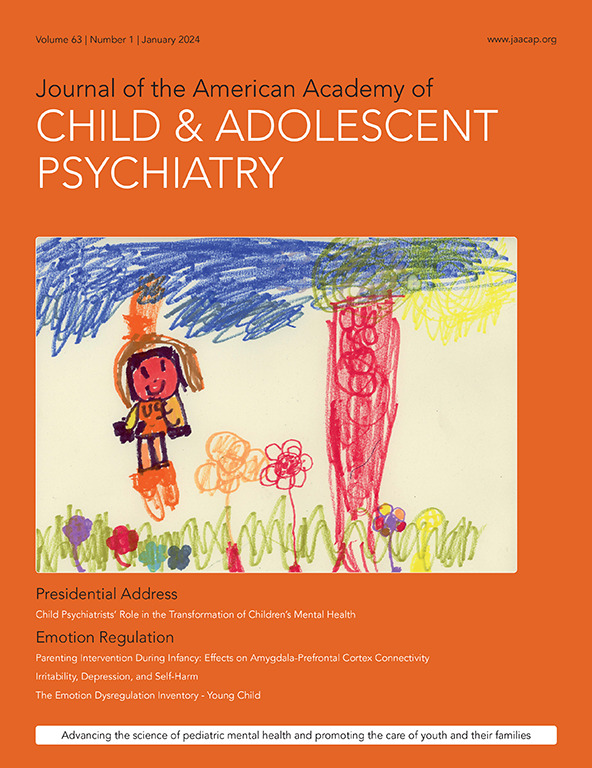系统综述和网络元分析:抗精神病药与抗癫痫药或锂治疗儿童和青少年急性躁狂症的疗效和安全性对比。
IF 9.2
1区 医学
Q1 PEDIATRICS
Journal of the American Academy of Child and Adolescent Psychiatry
Pub Date : 2025-02-01
DOI:10.1016/j.jaac.2024.07.920
引用次数: 0
摘要
目的:比较第二代抗精神病药物(SGAs)和情绪稳定剂(MSs比较第二代抗精神病药(SGAs)和情绪稳定剂(MSs)对躁狂/混合型双相情感障碍(BD-I)青年患者的治疗效果:方法:系统检索PubMed/Embase/PsycInfo文献,检索期至2023年12月31日,检索针对18岁以下BD-I躁狂/混合发作患者的SGAs或MSs随机试验。网络荟萃分析比较了有关躁狂症状和躁狂反应(共同主要结果)以及次要疗效和耐受性结果的治疗方法:18项研究(n=2844,平均年龄=11.74,女性=48.0%,平均研究时间=5.4周)比较了6种SGA(阿立哌唑、阿塞那平、奥氮平、喹硫平、利培酮、齐拉西酮)和4种MS(锂、奥卡西平、托吡酯、丙戊酸钠)。所有六种SGA在减少躁狂症状方面的表现均优于安慰剂,包括利培酮(SMD=-1.18,95%CI=-0.92;-1.45,CINeMA=中等置信度)、奥氮平(SMD=-0.77,95%CI=-0.36;-1.18,低置信度)、阿立哌唑(SMD=-0.67,95%CI=-0.33;-1.01,中等置信度)、喹硫平(SMD=-0.60,95%CI=-0.32,-0.87,高置信度)、阿塞那平(SMD=-0.54,95%CI=-0.19; -0.89,中等置信度)和齐拉西酮(SMD=-0.43,95%CI=-0.17-0.70,低置信度),而没有一种情绪稳定剂的表现优于安慰剂。47,中等置信度)、阿塞那平(RR=1.81,95%CI=1.28-2.55,极低置信度)和锂(RR=1.35,95%CI=1.00;1.83,P值=0.049,极低置信度)的疗效优于安慰剂,其他MSs与安慰剂相比没有优势。单独来看,利培酮在减轻躁狂症状方面的疗效优于除奥氮平和托吡酯以外的所有其他比较药,但可信度较低/非常低,且与催乳素和血糖升高有关。汇总结果显示,SGAs在减少躁狂症状(SMD=-0.68,95%CI=-0.86;-0.51和SMD=-0.61,95%CI=-0.82;-0.40,中等置信度)和躁狂反应(RR=1.85,95%CI=1.53;2.24和RR=1.65,95%CI=1.33-2.04,中等置信度)方面优于安慰剂和MSs,但MSs与安慰剂之间无差异。在全因停药方面,治疗与安慰剂之间没有明显差异,而与安慰剂相比,锂、齐拉西酮和奥卡西平与不良事件相关的停药率更高。与安慰剂和MS相比,大多数SGAs与更多的镇静、体重增加和代谢问题有关:结论:在治疗急性躁狂症状方面,SGAs 比安慰剂和 MSs 更有效,但在使用时必须仔细权衡其重要的副作用。本文章由计算机程序翻译,如有差异,请以英文原文为准。
Systematic Review and Network Meta-Analysis: Efficacy and Safety of Antipsychotics vs Antiepileptics or Lithium for Acute Mania in Children and Adolescents
Objective
To compare second-generation antipsychotics (SGAs) and mood stabilizers (MSs) in youth with a bipolar disorder type I (BD-I) manic/mixed episode.
Method
A systematic PubMed/Embase/PsycInfo literature search until December 31, 2023, for randomized trials of SGAs or MSs in patients ≤18 years of age with BD-I manic/mixed episode was conducted. The study included a network meta-analysis comparing treatments regarding mania symptoms and mania response (co-primary outcomes), and secondary efficacy and tolerability outcomes.
Results
Eighteen studies (n = 2844, mean age = 11.74, female participants = 48.0%, mean study duration = 5.4 weeks) comparing 6 SGAs (aripiprazole, asenapine, olanzapine, quetiapine, risperidone, and ziprasidone) and 4 MSs (lithium, oxcarbazepine, topiramate, and valproate) were meta-analyzed. All 6 SGAs outperformed placebo in reducing manic symptomatology, including risperidone (standardized mean difference [SMD] = −1.18, 95% CI = −0.92, −1.45, Confidence in Network Meta-Analysis [CINeMA] = moderate confidence), olanzapine (SMD = −0.77, 95% CI = −0.36, −1.18, low confidence), aripiprazole (SMD = −0.67, 95% CI = −0.33, −1.01, moderate confidence), quetiapine (SMD = −0.60, 95% CI = −0.32, −0.87, high confidence), asenapine (SMD = −0.54, 95% CI = −0.19, −0.89, moderate confidence), and ziprasidone (SMD = −0.43, 95% CI = −0.17, 0.70, low confidence), whereas no mood stabilizer outperformed placebo. Concerning mania response, risperidone (Risk ratio [RR] = 2.58, 95% CI = 1.88, 3.54, low confidence), olanzapine (RR = 2.42, 95% CI = 1.33, 3.54, very low confidence), aripiprazole (RR = 2.05, 95% CI = 1.44, 2.92, low confidence), quetiapine (RR = 1.89, 95% CI = 1.45n 2.47, moderate confidence), asenapine (RR = 1.81, 95% CI = 1.28, 2.55, very low confidence) and lithium (RR = 1.35, 95% CI = 1.00, 1.83, p = .049, very low confidence) outperformed placebo, without superiority of other MSs vs placebo. Individually, risperidone was more efficacious in reducing manic symptomatology than all other comparators, except olanzapine and topiramate, yet with low/very low confidence, and was associated with increased prolactin and glucose. Pooled together, SGAs outperformed both placebo and MSs for mania symptom reduction (SMD = −0.68, 95% CI = −0.86, −0.51 and SMD = −0.61, 95% CI = −0.82, −0.40, moderate confidence), and mania response (RR = 1.85, 95% CI = 1.53, 2.24 and RR = 1.65, 95% CI = 1.33, 2.04, moderate confidence) without differences between MSs and placebo. There were no significant treatment−placebo differences for all-cause discontinuation, whereas lithium, ziprasidone, and oxcarbazepine were associated with more adverse event-related drop-outs than placebo. Most SGAs were associated with more sedation, weight gain, and metabolic issues vs placebo and MSs.
Conclusion
SGAs were more efficacious than placebo and MSs in treating acute mania symptoms, however, their use must be carefully weighed against important side effects.
Plain language summary
In this systematic review, the authors compared second-generation antipsychotics and mood stabilizers in youth with bipolar disorder type I experiencing manic or mixed episodes. Drawing on data from 18 randomized trials involving 2,844 participants less than 18 years of age, the authors found that second-generation antipsychotics were more effective than both placebo and mood stabilizers in reducing manic symptoms. However, the authors recommended caution while using second-generation antipsychotics due to potential side effects such as sedation, weight gain, and metabolic issues.
Study preregistration information
Efficacy and Safety of Antipsychotics vs Antiepileptics or Lithium Used for Mood Stabilization in Bipolar Disorder in Children and Adolescents: A Systematic Review and Exploratory Network Meta-analysis of Head-to-Head Trials; https://www.crd.york.ac.uk; CRD42022370915.
求助全文
通过发布文献求助,成功后即可免费获取论文全文。
去求助
来源期刊
CiteScore
21.00
自引率
1.50%
发文量
1383
审稿时长
53 days
期刊介绍:
The Journal of the American Academy of Child & Adolescent Psychiatry (JAACAP) is dedicated to advancing the field of child and adolescent psychiatry through the publication of original research and papers of theoretical, scientific, and clinical significance. Our primary focus is on the mental health of children, adolescents, and families.
We welcome unpublished manuscripts that explore various perspectives, ranging from genetic, epidemiological, neurobiological, and psychopathological research, to cognitive, behavioral, psychodynamic, and other psychotherapeutic investigations. We also encourage submissions that delve into parent-child, interpersonal, and family research, as well as clinical and empirical studies conducted in inpatient, outpatient, consultation-liaison, and school-based settings.
In addition to publishing research, we aim to promote the well-being of children and families by featuring scholarly papers on topics such as health policy, legislation, advocacy, culture, society, and service provision in relation to mental health.
At JAACAP, we strive to foster collaboration and dialogue among researchers, clinicians, and policy-makers in order to enhance our understanding and approach to child and adolescent mental health.

 求助内容:
求助内容: 应助结果提醒方式:
应助结果提醒方式:


